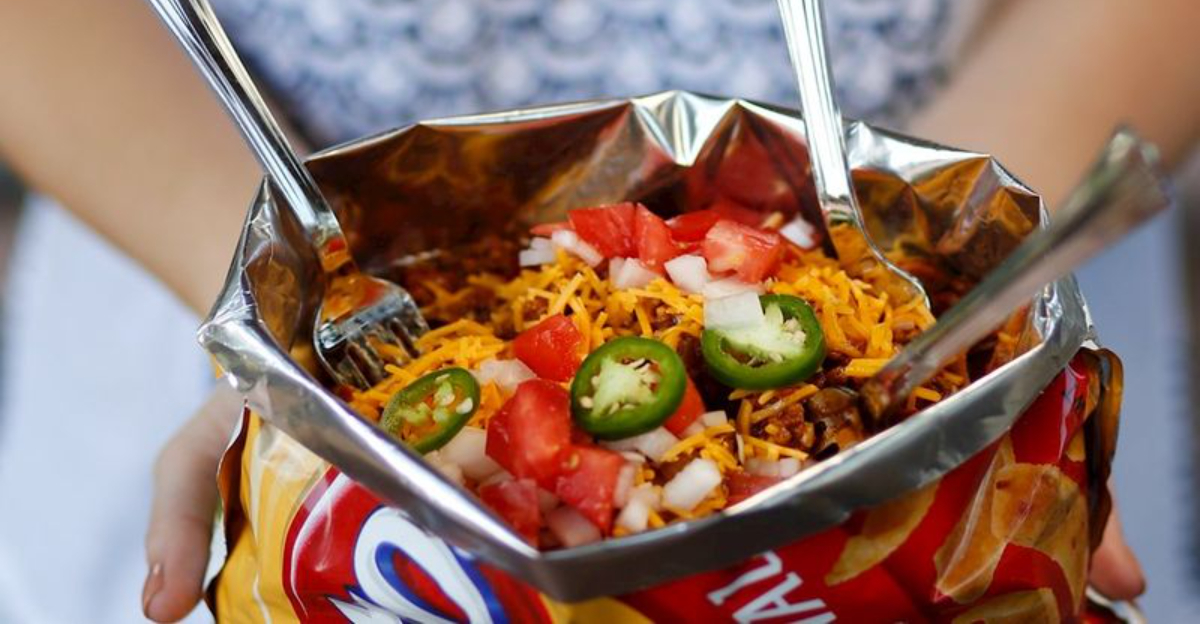19 American Dishes That Make Foreigners Deeply Uncomfortable

American cuisine often surprises visitors from other countries with its unique combinations, portion sizes, and ingredient choices. What seems normal to Americans can appear downright bizarre to those from different culinary traditions.
From sweet-savory combinations to deep-fried everything, these 19 American dishes consistently leave foreign visitors scratching their heads in confusion or recoiling in horror.
1. Spray Cheese from a Can
Nothing perplexes international visitors quite like watching Americans spray processed cheese directly from an aerosol can onto crackers.
The bright orange color and chemical taste are completely foreign concepts in countries where cheese is considered a natural, artisanal product. Many Europeans have been known to physically recoil when offered this convenience food.
The concept that cheese should be shelf-stable and squeezable challenges fundamental culinary beliefs held around the world.
2. Corn Dogs
The concept of impaling a hot dog on a stick, coating it in sweet cornmeal batter, and deep-frying the entire creation is quintessentially American state fair food.
For many foreigners, the combination of processed meat with a sweet coating creates a confusing flavor experience. The portable nature and carnival associations make corn dogs even more peculiar to international visitors.
Many cannot comprehend why Americans would take a perfectly normal sausage and transform it into what one German tourist described as “meat lollipops.”
3. Peanut Butter and Jelly Sandwiches
This lunchbox staple bewilders people from cultures where peanut butter is rare or used in savory dishes.
The sticky, dense peanut spread combined with sugary fruit preserves creates a texture and flavor combination that many find odd or excessively sweet.
Growing up, my Japanese pen pal visited and watched in horror as I made my daily PB&J. “You eat this every day?” she asked, taking a tiny bite before discreetly wrapping the rest in a napkin.
In many countries, the concept of mixing nut paste with fruit jam seems as strange as chocolate on pizza.
4. Biscuits and Gravy
Southern-style breakfast featuring soft, flaky biscuits smothered in thick, white sausage gravy confuses international visitors expecting something entirely different.
In most countries, “biscuits” are sweet cookies, and gravy is brown. The pale, chunky appearance of the gravy particularly disturbs first-time observers.
The heavy, filling nature of this breakfast dish also surprises those from cultures where morning meals tend to be light and simple, leaving them wondering how Americans function after such a substantial start to the day.
5. Sweet Potato Casserole with Marshmallows
Thanksgiving tables across America feature this dish that horrifies culinary purists worldwide. The combination of a vegetable side dish topped with candy marshmallows breaks fundamental food category rules that most cultures strictly observe.
Vegetables and candy simply don’t mix in most global cuisines. Foreign visitors often watch in disbelief as Americans serve what looks like dessert alongside savory turkey and stuffing, creating what one French chef called “a culinary identity crisis on a plate.”
6. Ranch Dressing on Everything
Americans’ habit of dousing everything from pizza to French fries in ranch dressing mystifies international visitors.
The creamy, herb-flecked condiment has achieved cult status in the US but remains virtually unknown or unused in most other countries. During college, my Italian roommate watched in horror as students in our dining hall poured ranch over pasta.
“This is a crime against my culture,” he declared. The tangy, garlicky flavor profile and the American tendency to use it as a universal sauce makes foreigners question our taste buds and culinary judgment.
7. Ambrosia Salad
This technicolor concoction of canned fruit, mini marshmallows, coconut, and whipped cream (sometimes bound with flavored gelatin but often just folded together) masquerading as a “salad” leaves international visitors speechless.
In most countries, the word salad implies vegetables and perhaps some protein, never sugary dessert ingredients. The visual impact alone is startling, with its bright artificial colors and fluffy, dessert-like texture.
Visitors from health-conscious countries like Japan or Mediterranean regions often cannot comprehend how this sweet mixture qualifies as anything other than a dessert, much less something called a “salad.”
8. Chicken and Waffles
The soul food combination of crispy fried chicken served atop sweet breakfast waffles with maple syrup defies culinary categorization for most foreign visitors. The sweet-savory-crunchy-soft contrasts create taste confusion for those not raised with this tradition.
Many Europeans express particular bewilderment at the dish crossing traditional mealtime boundaries. “Is it breakfast? Is it dinner?” questioned my German colleague when first encountering it on a menu.
The addition of maple syrup over fried chicken seems especially perplexing to those from Asian countries where sweet and savory remain distinctly separated.
9. Kool-Aid Pickles
Popular in the South, these bright red, sweet-sour pickles created by soaking dill pickles in Kool-Aid represent American food experimentation at its most bewildering.
The neon color and clash of flavors make them Instagram-worthy but horrifying to culinary traditionalists. I watched my cousin prepare these for a family reunion, and my French exchange student nearly fainted at the sight.
The deliberate transformation of a perfectly good pickle into something that looks like it came from a science experiment epitomizes what many foreigners find most perplexing about American food: our willingness to manipulate perfectly good ingredients into something unrecognizable.
10. CheezWhiz
This processed cheese product comes in a jar and remains spreadable at room temperature before opening, properties that cheese-loving nations find deeply disturbing.
The unnaturally smooth texture and ability to last for months on the shelf (though the label instructs refrigeration after opening) contradict fundamental beliefs about what cheese should be.
The bright orange color bears little resemblance to any natural cheese. Visitors from countries with strong cheese-making traditions like France, Italy, or Switzerland often cannot reconcile this product with their understanding of cheese, viewing it as a strange American invention.
11. Pumpkin Spice Everything
When autumn arrives, Americans embrace pumpkin spice flavoring in everything from coffee to potato chips, cereal, and even spam.
This seasonal obsession confuses visitors who see pumpkin as a savory vegetable, not a sweet flavoring agent. Most cultures use pumpkin in soups or savory dishes.
The American transformation of this gourd’s flavor profile into a sweet, cinnamon-clove-nutmeg combination that appears in virtually every food category during fall months seems like bizarre seasonal madness to those not raised with this tradition.
12. Tater Tot Casserole
This Midwestern staple, combining frozen potato nuggets, canned cream soup, and ground beef, topped with melted cheese, represents comfort food to many Americans but culinary horror to visitors.
The heavy use of processed ingredients and casserole format creates textural confusion. Last year, my Norwegian relative visited during the winter and watched me prepare this dish. “You’re putting frozen potatoes on top of soup from a can?” she asked incredulously.
The concept of combining multiple processed ingredients into a single-dish meal particularly troubles visitors from countries where fresh, simple cooking is the norm.
13. Miracle Whip
This mayonnaise alternative, with its distinctive sweet-tangy flavor profile and unnatural sheen, disturbs mayonnaise purists from countries like France and Japan.
The very concept of “sandwich spread” as a category confuses those from culinary traditions where mayonnaise has specific, limited uses. The sweet undertone particularly bothers Europeans accustomed to more acidic, egg-forward mayonnaise.
Many visitors mistake it for actual mayonnaise on first encounter, leading to a jarring taste surprise that one Belgian tourist described as “mayonnaise that’s having an identity crisis and thinks it’s dessert.”
14. Jell-O Salads with Vegetables
Mid-century American cuisine produced these colorful molded gelatin creations containing suspended vegetables, fruits, and sometimes meat.
Modern international visitors encounter these retro dishes at church potlucks or grandma’s house with absolute bewilderment.
The concept of trapping savory ingredients like celery, carrots, or olives within sweet, jiggly gelatin defies culinary logic to most non-Americans.
The visual impact of seeing vegetables floating in translucent colored gelatin creates an immediate visceral response that one Japanese visitor described as “food that looks like it belongs in a science museum, not on a plate.”
15. Frito Pie Served in the Bag
This Southwestern creation involves opening a small bag of Fritos corn chips and pouring chili, cheese, and onions directly inside to be eaten from the bag. The presentation alone shocks visitors expecting food to be served on proper dishware.
When attending a high school football game in Texas, my cousin from England watched in disbelief as fans purchased and consumed this portable meal. “Are they really eating straight from a chip bag?” he whispered.
The casual approach to combining snack food packaging with hot main dish components exemplifies American pragmatism that prioritizes convenience over traditional dining conventions.
16. Turducken
This Thanksgiving showstopper features a chicken stuffed inside a duck stuffed inside a turkey, creating a meat inception that horrifies those from cultures with more restrained approaches to protein.
The excessive nature of combining three birds into one roast seems unnecessarily extreme to most international observers. The name alone sounds like a joke to non-English speakers.
The concept represents American excess in its most literal form, taking not one but three separate birds and combining them into a single dish that requires hours of preparation and cooking time, leaving visitors wondering why Americans can’t simply enjoy one bird at a time.
17. Deep-Fried Butter on a Stick
State fairs across America showcase this ultimate deep-fried indulgence: frozen butter dipped in batter, fried, and served on a stick. The very concept sends health-conscious visitors from other countries into shock at the caloric implications.
The first time I described this to my Japanese pen pal, she thought I was joking. “But butter is already a cooking ingredient, not something you eat directly,” she protested.
This dish represents the American state fair tradition of pushing deep-frying to its logical extreme, creating novelty foods that even many Americans find excessive.
18. Garbage Plate
Rochester, New York’s famous late-night creation piles macaroni salad, home fries, meat sauce, onions, mustard, and choice of protein onto a single plate in a magnificent mountain of food. The name alone terrifies visitors before they even see the chaotic presentation.
The sheer volume and seemingly random combination of components violate fundamental principles of meal composition held sacred in many cultures.
Each element touches the others in a way that would horrify diners from countries where food separation is important, creating what one Italian visitor described as “a plate that looks like it’s already been digested once.”
19. Scrapple
This Pennsylvania Dutch creation, made from pork scraps and trimmings combined with cornmeal and flour into a loaf that’s sliced and fried, challenges even adventurous international eaters.
The concept of transforming meat scraps into a breakfast food seems particularly strange to those unfamiliar with nose-to-tail eating traditions. The gray-brown appearance and soft texture before frying doesn’t help its case.
When served to a group of European visitors at a cultural exchange breakfast, most politely took the smallest piece possible, with one French tourist whispering, “Is this what Americans consider punishment food?”
